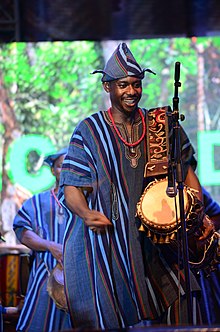Ìran Yorùbá
Ìran Yorùbá, àwọn ọmọ Yorùbá tàbí Ọmọ káàárọ̀-oòjíire, jé árá ìpinle ẹ̀yà, ní apá ìwọ̀ oòrùn ilẹ̀ Áfríkà. Wọn jé árá ìpin àwọn ìran to pò ju ní orílẹ̀ Áfríkà. Ilẹ̀ Yorùbá ní púpò nínú wọ́n.[1] Ẹ lè ri wọ́n ní ìpínlẹ̀ púpò bíi ìpínlẹ̀ Ẹdó, Ìpínlẹ̀ Èkìtì, ìpínlẹ̀ Èkó, Ìpínlẹ̀ Kwara, ìpínlẹ̀ Kogí, ìpínlẹ̀ Ògùn, Ìpínlẹ̀ Oǹdó, ìpínlẹ̀ Ọ̀ṣun, ìpínlẹ̀ Ọ̀yọ́, àti ní ẹ̀yà ila ọ́wọ́ òsi ti ilè Nàìjíríà. Ẹ tún le rí wọ́n ní ìpínlẹ̀ to wa nínú orílẹ̀-èdè Olómìnira Benin (Dahomey), ní orílẹ̀-èdè Sàró (Sierra Leone), àti ní àwọn orílẹ̀-èdè miiran bíi àwọn tí wọ́n pè ní Togo, Brazil, Cuba, Haiti, Amẹ́ríkà ati Venezuela. Àwọn Yorùbá wà l’árá àwọn to tóbí ju ní orílẹ̀-èdè Nàìjíríà. Ó le jẹ́ pe àwọn lo pọ̀ jù, abí kí wọ́n jẹ́ ìkejì, tàbí ẹ̀yà kẹta tí wọ́n pọ̀ jùlọ ní orílẹ̀-èdè Nàìjíríà.[2][3]

Àwọn Yorùbá jẹ́ àwọn ènìyàn kan ti èdè wón pín sí orísirísi. Diẹ̀ lára àwọn ìpínsísọ̀rí àwọn èdè wọn ni a ti ri: "Èkìtì"; "Èkó"; "Ìjèbú"; "Ìjẹ̀ṣhà"; "Ìkálẹ̀"; "Ọ̀yọ́"; "Ẹ̀gbá" àti bẹ́ẹ̀ bẹ́ẹ̀ lọ. Àwọn ìpínsísọ̀rí yí ni a ń pe ní ẹ̀ka èdè tàbí èdè àdúgbò. Ìran Yorùbá je ènìyàn kan tí wọ́n fẹ́ràn láti máà se áájò àti àlejò àwọn ẹlẹ́yà míràn, wọ́n sì ma ń nífẹ́ sí ọmọ'làkejì.
Èdè
àtúnṣeÈdè Yorùbá jé èdè ti àwọn ìran Yorùbá ma'ń sọ sí ara wọn. Ójẹ́ èdè to pé jù ni ilẹ́ Yorùbá. Ẹ lè ri èdè yi ni Ilẹ Nàìjíríà, Ilẹ Benin, ati ni Ilẹ Togo. Iye to'n sọ èdè yi ju ni gbogbo ilẹ́ Yorùbá 30 milliọnu lọ.[4][5]
Àwọn Ìtọ́kasí
àtúnṣe- ↑ "Yoruba People". New World Encyclopedia. 1960-10-01. Retrieved 2023-06-13.
- ↑ "Yoruba - Introduction, Location, Language, Folklore, Religion, Major holidays, Rites of passage". World Culture Encyclopedia. 2007-04-03. Retrieved 2023-06-13.
- ↑ "Yoruba People of Nigeria – Yoruba People History & Culture". Guide to Nigeria tourism, local culture & investments. 2015-09-13. Retrieved 2023-06-13.
- ↑ "Yoruba - people". Encyclopedia Britannica. 1998-07-20. Retrieved 2023-06-13.
- ↑ study.com https://study.com/learn/lesson/yoruba-people-language-culture-history-music.html. Retrieved 2023-06-13. Missing or empty
|title=(help)